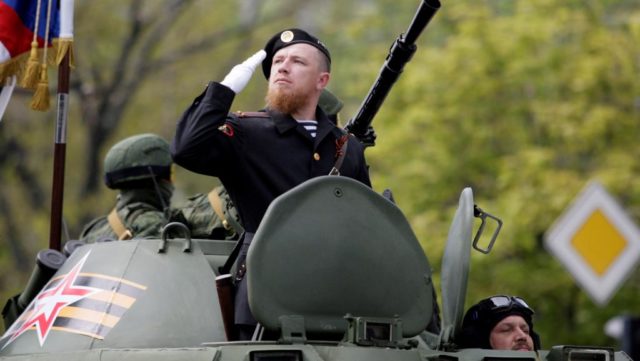
As Russian Support for Ukrainian War Ebbs, Kremlin Mulling New ‘Hybrid’ Tactics
Publication: Eurasia Daily Monitor Volume: 14 Issue: 141
By:

Vladimir Putin’s Anschluss of Crimea gave him a big political boost, and Russians still overwhelmingly support the annexation of that Ukrainian peninsula. But support for Russian forces and their clients in Donbas is declining, with ever more Russians against backing these breakaway groups and expressing fears that the conflict there could grow into a major war with the West (Levada.ru, October 30). These attitudes, especially on the eve of presidential elections, have prompted Putin to adopt what one Russian commentator calls “a fake demilitarization.” Specifically, the Kremlin suggests it will do what it can to end Russian military losses and risks abroad (Rosbalt, Windowoneurasia2.blogspot.com, October 30).
But there is little evidence that Putin’s new “peace offensive” reflects a fundamental change in his plans to destabilize, undermine and ultimately ensure Russian dominance over Ukraine. Some Kyiv commentators even argue that he will soon launch a new, full-scale attack on the country (Apostrophe.ua, October 20). Such a move is highly unlikely until after the March elections for at least two reasons. First are concerns over the presidential campaign itself. Putin might discover that armed escalation now, especially if it results in massive Russian losses, would hurt more than help him with Russian voters. Second, the season is wrong: attacking in the winter would be difficult and give many advantages to Ukrainian defenders.
What then is Putin likely to do? The most probable answer is that he will seek to develop and apply new “hybrid” forms of aggression in order to weaken the Ukrainian state and thus reduce the likelihood that the West will decide to provide Kyiv with the lethal arms it needs and seeks. That was the logic behind his use of “little green men” in Crimea, in 2014. And it remains the basis of his policies both in Donbas, where Moscow continues to deny it is running the show, and elsewhere in Ukraine, where the Russian government is using both corruption and targeted violence against its opponents (UAWire, November 1).
One such new “hybrid” form apparently under consideration is the promotion of atamanshchina, both as a scarecrow designed to frighten Ukrainians and put off their Western supporters, and as a means of spreading Russian influence beyond the confines of occupied Crimea and Donbas. The term is not familiar to most in the United States, but it occupies an important place in Russian and Ukrainian thought. According to US historian Canfield F. Smith, the term “connotes in one word” in Russian “what it takes several words in other languages to describe” (Canfield F. Smith, “Atmanshchina in the Russian Far East,” Russian History/Histoire Russe, 6:1 (1979): 57).
In general, Smith writes, the suffix “-shchina” “means ‘the evil deeds of’ the name that precedes it,”—thus, the “Pugachevshchina” for the peasant revolt against Catherine the Great, led by Yemelyan Pugachev, and the “Yezhovshchina” for the bloodiest period of Joseph Stalin’s repression in the 1930s. But its most frequent application has been to the partisan leaders (“atamans”) on both sides in the Russian Civil War, 1917–1922, especially in what is now Ukraine and the Russian Far East. Many of the atamans at that time were little more than brigands who maintained their power by brutal means. They often had little attachment to any ideology—many of them changed sides. By their actions, these small-time warlords often drove the population over which they aspired to rule into the hands of whatever side they were not on at any particular time.
A year ago, some Russian writers were expressing concern that problems within the chain of command in separatist Donbas were leading to the rise of atamanshchina there, which they insisted Moscow should suppress (Iarex.ru, July 3, 2016; Windowoneurasia2.blogspot.com, July 4, 2016). Now, however, several Russian observers are viewing this phenomenon not as a threat to Russian interests but as a tactic that can advance them—and at relatively little cost or risk to Russian lives.
In a commentary for Tsargrad television, the Moscow Patriarchate’s official and influential channel, Dmitry Pavlenko argues that “A New Atamanshchina Awaits Ukraine,” one not in Donbas but across the country, nominally organized by local people with arms and an anti-Kyiv agenda (Tsargrad.tv, October 25). His enthusiasm for something Ukrainians and others have good reason to fear as a result of their earlier experiences suggests that Moscow at a minimum welcomes this trend. And quite possibly, the Kremlin is doing what it can to promote it by leaking arms and money to those who might aspire to regional power as updated versions of the atamans of the Russian Civil War.
Pavlenko argues that an “Atamanshchina 2.0” would conform to the Hegelian principle that when history repeats itself, what once was a tragedy comes back as a farce. Moreover, he says that this revival would not only remind everyone of the brutalities of the first atamans, many of whom were notoriously anti-Semitic, but also lead to the complete fragmentation of Ukraine—something Kyiv and the West oppose but that Moscow has already shown it is prepared to promote.
Consequently, in the coming weeks and months, the appearance of ataman-like figures in parts of Ukraine is quite likely, especially since it appears they now will enjoy not the backing of the Ukrainian people but of the powers that be in the Kremlin.



